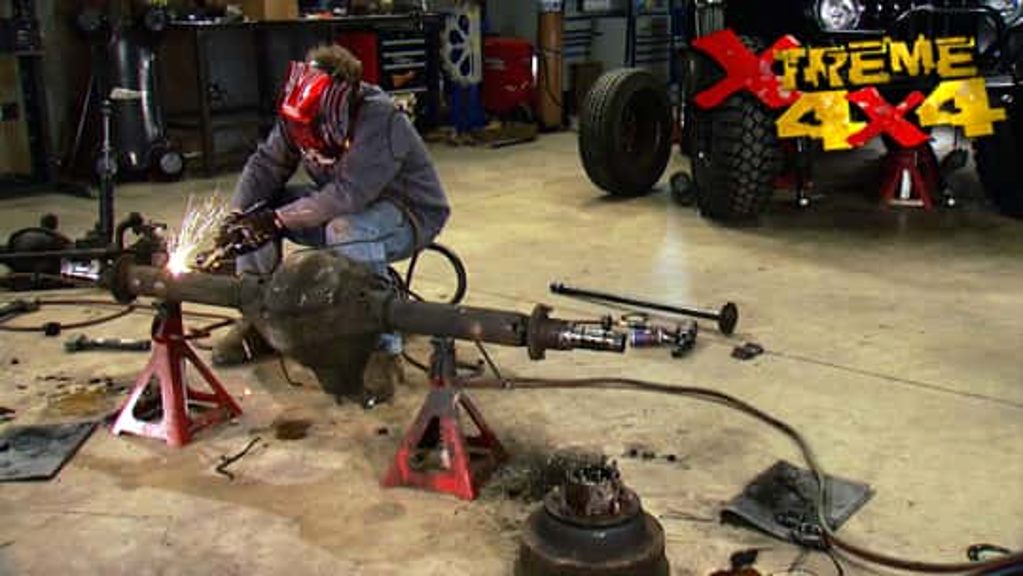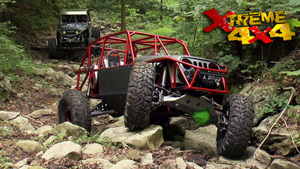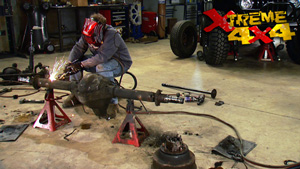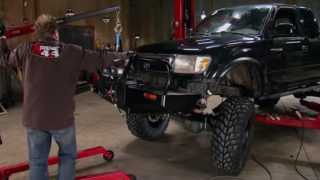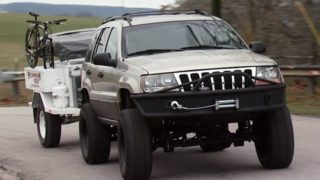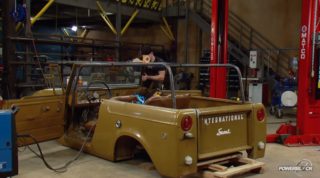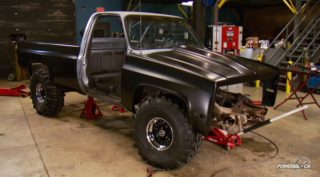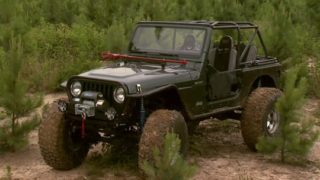More Budget TJ Episodes
Xtreme 4x4 Builds
Want more content like this?
Join the PowerNation Email NewsletterParts Used In This Episode
Allied Wheels
Raceline 17 x 9.5 8 lug RT231 Competition Beadlock Series Monster Black
ARB 4x4 Accessories
ARB Air Locker Locking Differential
ARB 4x4 Accessories
ARB Air Locker Locking Differential
Blue Torch FabWorks
Differential Cover and Axle Truss for Dana 60
Crane Hi Clearance
Crane Dana 60 King Pin Chromoly Outer Knuckle kit
Kick Ass Off Road/Performance Cryogenics
Axle Alignment and Bar Jig
Maxxis International
40 X 13.50 - 17 Maxxis M8090 Creepy Crawler.
RCV Performance Products
Dana 60 CV Axle Set
Rusty's Off Road
TJ Suspension Mounting Axle Brackets
Warn Industries
Manual Locking Hub Set
Episode Transcript
Today, we're going to tackle a job that sooner or later, almost every off Roader has to do. It doesn't matter if you're building a two buggy, a cab truck or even a Jeep. Eventually you're going to want a set of custom with axles. You got two choices. You can order a set of crate axles or you can go to a junkyard, get a couple of old axles and make them a custom with yourself. And this is a case where building is always cheaper than buying
and that's what we're gonna do today. We're gonna take you step by step through the process of taking a junkyard axle and turning it into a custom wid axle to fit this Jeep TJ. We'll do everything from choosing the
wi how to locate your opinion, how to deal with some alignment angles as well as all the parts and the tools you're gonna need to get them to fit underneath your truck. But before we put any custom axles underneath this, Jeep,
the old ones have to come out.
This first step may seem silly, but we're going to start by taking some measurements with the truck sitting on its tires and wheels,
we measure the caster angle, the top of the factory c
the angle of all the suspension links.
And finally, we'll check the pinion angle. These are all critical, especially if you're going to run the truck on the street.
Our narrowed axles will be built specifically for this Jeep.
But everything we do here today pertains to any project where you're gonna be replacing an axle with a junkyard unit.
I'm sure some of you guys are wondering why we spend so much time here taking axles out of trucks and replacing them with larger units that we've pulled from a junk yard. Well, we do it because we're chasing the strength of that larger axle. You see, Jeep can get away with installing one of these small Dana thirties underneath the front of the TJ for a bunch of different reasons. The vehicle's light doesn't have a lot of horsepower, not a lot of gearing. And most importantly, the tires are not that tall from the factory. That means you're probably going to get this truck stuck before you.
Any worries of breaking any of the internal components on this axle, throw a lift kit, larger wheels and tires and this axle's days are numbered underneath your truck.
That's why you swap it out to a larger heavier axle. This is a day in a 60 out of a one ton truck. Now, a one ton truck is obviously heavier, has more horsepower. A little bit more gearing and a little bit larger tires and it's designed to handle really heavy amounts of abuse. That's why this axle will be able to handle the larger wheels and tires on our project.
Now, the first thing you're gonna need to determine when you're looking for a junkyard axle is what drop or side of the vehicle. The transfer case comes out on ours on our TJ is a driver's side drop. That means we can use this Ford Dana 60 which is nice because on the driver's side drop, it was offered in a high pinion, which means we've got a lot more ground clearance for a front drive shaft and more importantly, a better drive angle.
Now, we can go ahead and pretty much clean this axle up and install it in what's called full width right out of the junkyard. Just like this problem. There is, the tires would stick out way past the body of the jeep. It's ok for trail riding. Not so great when you're driving on the highway. That's why we need to do a custom width. We'll narrow this axle up. So it is a little bit wider than this. It'll fit the jeep perfectly and give us the strength that we're after.
And then
instead of disassembling the outer hub assembly, we're just gonna go ahead and cut it all off right at the inner seat.
It's a good idea to have the tires and wheels that you wanna use on your project around so you can determine the true full width of your new narrowed axle. Now, we're gonna use these 40 inch tall creepy crawlers mounted on these 17 inch Allied Rock Aon bead locks. And the first thing we're gonna do is just simply roll them underneath the body of the Jeep and get a rough idea of where they're going
it. Now, you don't want them sticking out so far that they're past the body lines of the truck. I could get you in trouble with the law depending on what state you live in. And also you don't want them tucked in so far that when you turn the wheel, it contacts the frame or you won't be able to make a right or a left hand turn, just get them in a ballpark figure, get them set up about where you want
and it's time to start measuring.
Now, this may take a couple of tries, use a plumb bob off the fender to determine the center line of the tire and then just match them up side to side. Now, on a Jeep, like ours stock width plus one or two inches works very well. That's what we're going to aim for.
Now, the location of this front drive line input is crucial when you're building a custom width, front axle, we know the total width right now is 62 inches. But if we just guessed where the pinion was gonna land, we can run into a problem if we put it too close to the center of the truck. When the suspension travels up and down, the drive shaft is gonna hit the transmission too close to the outside edge, it can hit the frame or even this link bar. We need
to have the input as close to the stock location as we can. That way when the suspension compresses, the drive line can travel up and down and not contact any part of the truck or bind. Now, we do that by simply placing on a jack stand and then measuring the distance from the center line of this U joint to the outside edge of this tire that becomes the total length of our short side axle tube.
Then we'll take that short side distance and subtract it from our total width of 62 inches that will tell us where we need to cut this long side tube to get this axle shortened down to our new custom width. But before we do any cutting on this housing, we need to take into account the distance that the inner sea knuckle and break water are going to add to the total width. And for that, we need some new parts.
Now, we could simply clean up our stock Dana 60 Inner Sea and knuckle assembly and reuse them. But instead, we're gonna throw a little bit of money at this project and get a definite strength upgrade. We're gonna install the crane, high clearance chrome
Molly 8620 Dana 60 Inner Sea and their kingpin knuckle assembly. Now, the reason we like the kingpin upgrade is it uses a small tape
roller bearing on the bottom as well as an actual kingpin on the top to secure the knuckle to the axle. Instead of a ball joint, ball joints are a little bit weaker. Although the kingpin does require more maintenance, the strength upgrade is definitely worth it. One other benefit we get is a keyed high steer arm
that's grooved out of the middle to lock into place. So we don't rely on the bolts to simply hold this onto the axle.
Now, what we have to do now is assemble the whole thing as a package off of the axle, put the spindle on here, take a rotor and hat and bolt it all together and then take a measurement we're measuring from the front edge of the inner sea out to the face of the rotor. That's how much width we're adding to our axle by making it a steering axle. Once we have that measurement, we'll put it together with our total width and we can cut up our axle.
No,
here
up next, more custom with axel
tech, how to use an alignment bar and cut up a rear 60. When Xtreme 4x4 continues
today, we're taking you guys step by step through the procedure of building custom with axles. Now, so far, we've been focusing on the front axle. We've stripped down this high pinion Dana 60 determined a new wind and then cut the tubes to fit and we installed our crane, high clearance inner seats as well as our chrome Molly kingpin knuckle assemblies. Now, before we do any welding on this axle, we want to make sure we set all of our angles and for that,
we need a special tool.
The tool we're going to use is called an alignment bar. We got ours from kick ass off road.
Two pucks are held by the bearing caps in the center section
and then the bar is slid through the spindles aligning it finally to alignment nuts are threaded onto the end of the spindle.
Now, the purpose of this alignment bar is to make sure that our axle shafts run perfectly true. We're taking the center line of this spindle and lining it up perfectly with the outputs of the locker that's inside the center section. That's why we have these pucks
underneath the bearing caps, keeps it all in a perfectly straight line. And the reason we want to do that is because the axle shafts that are inside of full float housing like a front
axle or even a full float rear, they're designed to handle huge amounts of torsional or twisting load. If you've ever seen a destructive test of an axle shaft, you'd actually see it turn almost 360 degrees before it will break. The one area they have that's weak is side loading or weight loading. If this spindle is off the center line by as little of an eighth of an inch, it's going to put side loaded pressure on the
raft as you're driving it down the road can cause premature failure and it can cause it to break before you do any wheeling at all. That's why an investment into an axle jig like this is worth the money. Now, we have it all jigged up. We're going to reset all of our angles. Now, we'll go ahead, set the pinion angle back to how our stock axle was. When it was underneath the jeep, we'll set our caster angle on our knuckles and then we'll go ahead and weld it all up.
Now, while the front axle cools, we'll go ahead and start narrowing up this rear axle. Now, everything is the exact same as the front except we don't have any inner seats or knuckles to deal with. All we'll do is cut the outer spindle off the end of the housing, measure it for length, trim, the tubes down, move the spindle in, put the alignment bar in fully weld it and we'll have two custom width axles.
The
with both our axles shortened, narrowed and fully welded to our new width of 62 inches. It's time to test fit them underneath the truck. Now, if we were building these with a custom suspension system. All we'd have to do is add some brackets and tabs, maybe a couple of mounts for our coil overs and we'd be good to go, but we're not on this Jeep. We installed an off the shelf TJ lift.
Now, for that, we need some very specific brackets. Now, we got our set from Rusty's Off road and they include all the brackets that we need to adapt a custom axle to that TJ suspension kit. They are set up for the smaller 2.5 inch axle tube. So we will have to open them up and modify them slightly. But once we have in tact in place, we can test fit our axle.
Now we have to make some changes on our rear axle. We can't just use the off the shelf bracket kit that we got from Rusty's because the Terra
Flex suspension system we installed, removed the panhard bar and we installed this trust system over the top of the housing to have a true triangulated for
leg.
So we need to do the same with our new data 60. So what we have is a trust system that we got from Blue Torch fab.
Now it's an integrated diff cover and truss system. So we'll get protection for our ring gear and then it will key off the top of the diff cover and lock it into place and then just simply weld onto the axle tubes Now we'll go ahead and install this with the axle on the stand and then we'll put underneath the truck to the lower link mounts
with two custom width axles mocked up underneath our truck. It's time for us to make a serious decision about our lockers and our gear set. Now, if you have a short wheelbase rig, like our Jeep here, you really wanna opt for a selectable locker. And the reason for that is with a spool or mechanical locker in that rear axle. When you're out on the trail, it'll tend to steer the truck around a little bit and you can get hung up on obstacles. So long wheelbase rig, it doesn't make a big difference. But when you're short, like our TJ, being able to unlock that rear axle really tightens up your turning radio
and keeps you going down the trail. Now, when you're talking about selectable lockers, a name that always comes up is the A RB air locker. Now, they've been around for years and this is their classic RD 35 unit. It uses compressed air to lock the axle together and give you that true spool action. When you release the air, you have that differential action or open differential and this unit will be going in the back of our jeep in the front. We're going to be installing the new version of their day in the 60 locker. You can see they've trimmed the case down a little bit to make it a lot lighter.
They've also integrated a one piece designed to give it a little bit more strength.
They've also moved the air actuating solenoid to the backside of the ring gear to protect the tube that delivers the air when you're running it inside the axle. Now, our gear set we got from superior axle gear and we're going to be running a set of 513 gears, both front and rear. Now, we opted for the 513 s because we are not going to do any transfer case gearing upgrades inside of our Jeep and we need that extra gearing down in the axle. Now, when you choose your gear set, make sure you all
order a complete master overhaul kit. It'll come with all the shims, new bolts, seals and bearings needed to properly install your gear set and your locker into your axle. Now, we're not gonna take you step by step through the process of installing this locker and gear set today. We've done that many times, but if you need a refresher course on how to install a ring opinion and an A RB air locker, go to our website, put together a little article there for you. They'll take you step by step through the procedure of installing, setting up your gear set inside the data series axle.
You're watching Xtreme 4x4 for a DVD copy of this episode. Just go to power block tv.com and order your copy for just 595 plus shipping and handling. Start your own Xtreme 4x4 collection delivered right to your door from the power block.
Now with our A RB air lockers and our gear set all set up in the axle, we're not going to talk about some areas that some guys forget to deal with when they're building custom with units like we are here. And the first is going to be axle shafts no matter how much you plan. The best way to make sure you have the correct length shaft is to go ahead and get the axle completely assembled like this and then check the length in order for the shafts and that can take a week or up to three weeks depending on who you get your shafts from. So plan for that downtime for your project. Now, on our truck, we're going be using these R CV performance shafts. Now, instead of using a typical axle joint, it uses this large CV joint that fits inside the inner C. Now it's a little bit stronger than the standard Dina 60 unit because it shares the load across all six balls housed inside this constant velocity joint. You do need a little bit more space for this unit inside your inner knuckle because we're running these crane units, we will have no problem at all. Now, no matter what kind of axle shafts you plan to run. The first step is going to be measuring for them. And that's an important step.
Using an old axle shaft will slide it down the tube and engage it in the spines in the locker. And then we will mark the outer edge of the inner seat
and we'll add the length of the axle joint girdle
and record the measurement
and we'll measure the seal location and spine length.
All this information is sent to our axle builder.
Now, another area of concern is gonna be the brakes. Now up front, we installed Chevy spindles on our knuckles and that allows us to order this rotor and hub assembly straight from General Motors and install it with a new caliper bracket on the back. This is a great place for an upgrade. We're gonna ditch the stock drum brakes and replace it with a disc brake conversion using a whole host of aftermarket goodies
using a dimpled and slotted brake rotor from E BC brakes will not only give us a brake upgrade from swapping the drums to the disks,
but the dimples and the slots in the rotor will help dissipate the gas that's created by braking
that will give us better break in pressure.
Now, the E BC pads with their break in material will burnish to the rotors faster, eliminating the extended break in period.
Now, the last decision you need to make about your custom with front axle is what type of outers to run. You got a couple of different options,
you can use a set of freewheeling hubs like these ones from Warn or what competition off roaders use. And that's a drive puck or drive Flan.
Now, if your vehicle is going to see any highway miles at all, you're better off to go with the free wheeling hub. And that's what we're going to choose because when we take the truck out on a dry pavement, we can unlock the wheels and they'll just turn freely and not turn the shafts or the center section of the axle at all. They'll save us a little bit of fuel. Now, obviously, before I put this axle back underneath the truck, I need to get the axle shafts in it. And the next time we have the jeep in the shop, we'll go ahead and take care of some transfer case upgrades and do some interior work.
Thanks for watching the stream.
See you next week.
Show Full Transcript
and that's what we're gonna do today. We're gonna take you step by step through the process of taking a junkyard axle and turning it into a custom wid axle to fit this Jeep TJ. We'll do everything from choosing the
wi how to locate your opinion, how to deal with some alignment angles as well as all the parts and the tools you're gonna need to get them to fit underneath your truck. But before we put any custom axles underneath this, Jeep,
the old ones have to come out.
This first step may seem silly, but we're going to start by taking some measurements with the truck sitting on its tires and wheels,
we measure the caster angle, the top of the factory c
the angle of all the suspension links.
And finally, we'll check the pinion angle. These are all critical, especially if you're going to run the truck on the street.
Our narrowed axles will be built specifically for this Jeep.
But everything we do here today pertains to any project where you're gonna be replacing an axle with a junkyard unit.
I'm sure some of you guys are wondering why we spend so much time here taking axles out of trucks and replacing them with larger units that we've pulled from a junk yard. Well, we do it because we're chasing the strength of that larger axle. You see, Jeep can get away with installing one of these small Dana thirties underneath the front of the TJ for a bunch of different reasons. The vehicle's light doesn't have a lot of horsepower, not a lot of gearing. And most importantly, the tires are not that tall from the factory. That means you're probably going to get this truck stuck before you.
Any worries of breaking any of the internal components on this axle, throw a lift kit, larger wheels and tires and this axle's days are numbered underneath your truck.
That's why you swap it out to a larger heavier axle. This is a day in a 60 out of a one ton truck. Now, a one ton truck is obviously heavier, has more horsepower. A little bit more gearing and a little bit larger tires and it's designed to handle really heavy amounts of abuse. That's why this axle will be able to handle the larger wheels and tires on our project.
Now, the first thing you're gonna need to determine when you're looking for a junkyard axle is what drop or side of the vehicle. The transfer case comes out on ours on our TJ is a driver's side drop. That means we can use this Ford Dana 60 which is nice because on the driver's side drop, it was offered in a high pinion, which means we've got a lot more ground clearance for a front drive shaft and more importantly, a better drive angle.
Now, we can go ahead and pretty much clean this axle up and install it in what's called full width right out of the junkyard. Just like this problem. There is, the tires would stick out way past the body of the jeep. It's ok for trail riding. Not so great when you're driving on the highway. That's why we need to do a custom width. We'll narrow this axle up. So it is a little bit wider than this. It'll fit the jeep perfectly and give us the strength that we're after.
And then
instead of disassembling the outer hub assembly, we're just gonna go ahead and cut it all off right at the inner seat.
It's a good idea to have the tires and wheels that you wanna use on your project around so you can determine the true full width of your new narrowed axle. Now, we're gonna use these 40 inch tall creepy crawlers mounted on these 17 inch Allied Rock Aon bead locks. And the first thing we're gonna do is just simply roll them underneath the body of the Jeep and get a rough idea of where they're going
it. Now, you don't want them sticking out so far that they're past the body lines of the truck. I could get you in trouble with the law depending on what state you live in. And also you don't want them tucked in so far that when you turn the wheel, it contacts the frame or you won't be able to make a right or a left hand turn, just get them in a ballpark figure, get them set up about where you want
and it's time to start measuring.
Now, this may take a couple of tries, use a plumb bob off the fender to determine the center line of the tire and then just match them up side to side. Now, on a Jeep, like ours stock width plus one or two inches works very well. That's what we're going to aim for.
Now, the location of this front drive line input is crucial when you're building a custom width, front axle, we know the total width right now is 62 inches. But if we just guessed where the pinion was gonna land, we can run into a problem if we put it too close to the center of the truck. When the suspension travels up and down, the drive shaft is gonna hit the transmission too close to the outside edge, it can hit the frame or even this link bar. We need
to have the input as close to the stock location as we can. That way when the suspension compresses, the drive line can travel up and down and not contact any part of the truck or bind. Now, we do that by simply placing on a jack stand and then measuring the distance from the center line of this U joint to the outside edge of this tire that becomes the total length of our short side axle tube.
Then we'll take that short side distance and subtract it from our total width of 62 inches that will tell us where we need to cut this long side tube to get this axle shortened down to our new custom width. But before we do any cutting on this housing, we need to take into account the distance that the inner sea knuckle and break water are going to add to the total width. And for that, we need some new parts.
Now, we could simply clean up our stock Dana 60 Inner Sea and knuckle assembly and reuse them. But instead, we're gonna throw a little bit of money at this project and get a definite strength upgrade. We're gonna install the crane, high clearance chrome
Molly 8620 Dana 60 Inner Sea and their kingpin knuckle assembly. Now, the reason we like the kingpin upgrade is it uses a small tape
roller bearing on the bottom as well as an actual kingpin on the top to secure the knuckle to the axle. Instead of a ball joint, ball joints are a little bit weaker. Although the kingpin does require more maintenance, the strength upgrade is definitely worth it. One other benefit we get is a keyed high steer arm
that's grooved out of the middle to lock into place. So we don't rely on the bolts to simply hold this onto the axle.
Now, what we have to do now is assemble the whole thing as a package off of the axle, put the spindle on here, take a rotor and hat and bolt it all together and then take a measurement we're measuring from the front edge of the inner sea out to the face of the rotor. That's how much width we're adding to our axle by making it a steering axle. Once we have that measurement, we'll put it together with our total width and we can cut up our axle.
No,
here
up next, more custom with axel
tech, how to use an alignment bar and cut up a rear 60. When Xtreme 4x4 continues
today, we're taking you guys step by step through the procedure of building custom with axles. Now, so far, we've been focusing on the front axle. We've stripped down this high pinion Dana 60 determined a new wind and then cut the tubes to fit and we installed our crane, high clearance inner seats as well as our chrome Molly kingpin knuckle assemblies. Now, before we do any welding on this axle, we want to make sure we set all of our angles and for that,
we need a special tool.
The tool we're going to use is called an alignment bar. We got ours from kick ass off road.
Two pucks are held by the bearing caps in the center section
and then the bar is slid through the spindles aligning it finally to alignment nuts are threaded onto the end of the spindle.
Now, the purpose of this alignment bar is to make sure that our axle shafts run perfectly true. We're taking the center line of this spindle and lining it up perfectly with the outputs of the locker that's inside the center section. That's why we have these pucks
underneath the bearing caps, keeps it all in a perfectly straight line. And the reason we want to do that is because the axle shafts that are inside of full float housing like a front
axle or even a full float rear, they're designed to handle huge amounts of torsional or twisting load. If you've ever seen a destructive test of an axle shaft, you'd actually see it turn almost 360 degrees before it will break. The one area they have that's weak is side loading or weight loading. If this spindle is off the center line by as little of an eighth of an inch, it's going to put side loaded pressure on the
raft as you're driving it down the road can cause premature failure and it can cause it to break before you do any wheeling at all. That's why an investment into an axle jig like this is worth the money. Now, we have it all jigged up. We're going to reset all of our angles. Now, we'll go ahead, set the pinion angle back to how our stock axle was. When it was underneath the jeep, we'll set our caster angle on our knuckles and then we'll go ahead and weld it all up.
Now, while the front axle cools, we'll go ahead and start narrowing up this rear axle. Now, everything is the exact same as the front except we don't have any inner seats or knuckles to deal with. All we'll do is cut the outer spindle off the end of the housing, measure it for length, trim, the tubes down, move the spindle in, put the alignment bar in fully weld it and we'll have two custom width axles.
The
with both our axles shortened, narrowed and fully welded to our new width of 62 inches. It's time to test fit them underneath the truck. Now, if we were building these with a custom suspension system. All we'd have to do is add some brackets and tabs, maybe a couple of mounts for our coil overs and we'd be good to go, but we're not on this Jeep. We installed an off the shelf TJ lift.
Now, for that, we need some very specific brackets. Now, we got our set from Rusty's Off road and they include all the brackets that we need to adapt a custom axle to that TJ suspension kit. They are set up for the smaller 2.5 inch axle tube. So we will have to open them up and modify them slightly. But once we have in tact in place, we can test fit our axle.
Now we have to make some changes on our rear axle. We can't just use the off the shelf bracket kit that we got from Rusty's because the Terra
Flex suspension system we installed, removed the panhard bar and we installed this trust system over the top of the housing to have a true triangulated for
leg.
So we need to do the same with our new data 60. So what we have is a trust system that we got from Blue Torch fab.
Now it's an integrated diff cover and truss system. So we'll get protection for our ring gear and then it will key off the top of the diff cover and lock it into place and then just simply weld onto the axle tubes Now we'll go ahead and install this with the axle on the stand and then we'll put underneath the truck to the lower link mounts
with two custom width axles mocked up underneath our truck. It's time for us to make a serious decision about our lockers and our gear set. Now, if you have a short wheelbase rig, like our Jeep here, you really wanna opt for a selectable locker. And the reason for that is with a spool or mechanical locker in that rear axle. When you're out on the trail, it'll tend to steer the truck around a little bit and you can get hung up on obstacles. So long wheelbase rig, it doesn't make a big difference. But when you're short, like our TJ, being able to unlock that rear axle really tightens up your turning radio
and keeps you going down the trail. Now, when you're talking about selectable lockers, a name that always comes up is the A RB air locker. Now, they've been around for years and this is their classic RD 35 unit. It uses compressed air to lock the axle together and give you that true spool action. When you release the air, you have that differential action or open differential and this unit will be going in the back of our jeep in the front. We're going to be installing the new version of their day in the 60 locker. You can see they've trimmed the case down a little bit to make it a lot lighter.
They've also integrated a one piece designed to give it a little bit more strength.
They've also moved the air actuating solenoid to the backside of the ring gear to protect the tube that delivers the air when you're running it inside the axle. Now, our gear set we got from superior axle gear and we're going to be running a set of 513 gears, both front and rear. Now, we opted for the 513 s because we are not going to do any transfer case gearing upgrades inside of our Jeep and we need that extra gearing down in the axle. Now, when you choose your gear set, make sure you all
order a complete master overhaul kit. It'll come with all the shims, new bolts, seals and bearings needed to properly install your gear set and your locker into your axle. Now, we're not gonna take you step by step through the process of installing this locker and gear set today. We've done that many times, but if you need a refresher course on how to install a ring opinion and an A RB air locker, go to our website, put together a little article there for you. They'll take you step by step through the procedure of installing, setting up your gear set inside the data series axle.
You're watching Xtreme 4x4 for a DVD copy of this episode. Just go to power block tv.com and order your copy for just 595 plus shipping and handling. Start your own Xtreme 4x4 collection delivered right to your door from the power block.
Now with our A RB air lockers and our gear set all set up in the axle, we're not going to talk about some areas that some guys forget to deal with when they're building custom with units like we are here. And the first is going to be axle shafts no matter how much you plan. The best way to make sure you have the correct length shaft is to go ahead and get the axle completely assembled like this and then check the length in order for the shafts and that can take a week or up to three weeks depending on who you get your shafts from. So plan for that downtime for your project. Now, on our truck, we're going be using these R CV performance shafts. Now, instead of using a typical axle joint, it uses this large CV joint that fits inside the inner C. Now it's a little bit stronger than the standard Dina 60 unit because it shares the load across all six balls housed inside this constant velocity joint. You do need a little bit more space for this unit inside your inner knuckle because we're running these crane units, we will have no problem at all. Now, no matter what kind of axle shafts you plan to run. The first step is going to be measuring for them. And that's an important step.
Using an old axle shaft will slide it down the tube and engage it in the spines in the locker. And then we will mark the outer edge of the inner seat
and we'll add the length of the axle joint girdle
and record the measurement
and we'll measure the seal location and spine length.
All this information is sent to our axle builder.
Now, another area of concern is gonna be the brakes. Now up front, we installed Chevy spindles on our knuckles and that allows us to order this rotor and hub assembly straight from General Motors and install it with a new caliper bracket on the back. This is a great place for an upgrade. We're gonna ditch the stock drum brakes and replace it with a disc brake conversion using a whole host of aftermarket goodies
using a dimpled and slotted brake rotor from E BC brakes will not only give us a brake upgrade from swapping the drums to the disks,
but the dimples and the slots in the rotor will help dissipate the gas that's created by braking
that will give us better break in pressure.
Now, the E BC pads with their break in material will burnish to the rotors faster, eliminating the extended break in period.
Now, the last decision you need to make about your custom with front axle is what type of outers to run. You got a couple of different options,
you can use a set of freewheeling hubs like these ones from Warn or what competition off roaders use. And that's a drive puck or drive Flan.
Now, if your vehicle is going to see any highway miles at all, you're better off to go with the free wheeling hub. And that's what we're going to choose because when we take the truck out on a dry pavement, we can unlock the wheels and they'll just turn freely and not turn the shafts or the center section of the axle at all. They'll save us a little bit of fuel. Now, obviously, before I put this axle back underneath the truck, I need to get the axle shafts in it. And the next time we have the jeep in the shop, we'll go ahead and take care of some transfer case upgrades and do some interior work.
Thanks for watching the stream.
See you next week.
